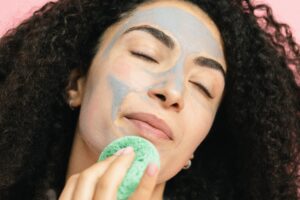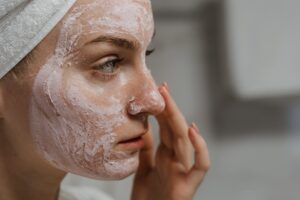How to Choose Gentle Alternatives for a Healthier, Glowing Skin

Exfoliation is an essential step in any skincare routine. It removes dead skin cells and impurities, leaving your skin smoother, brighter, and more youthful-looking. However, the type of exfoliant you use can make a huge difference in the health and appearance of your skin. While physical exfoliants may seem like a quick and easy solution to slough off dead skin, they can actually cause more harm than good in the long run. In this article, we’ll explore the dangers of harsh physical exfoliants and provide tips on how to choose gentle alternatives that won’t damage your skin.
Why Some Exfoliants Can Damage Your Skin
Physical exfoliants use abrasive ingredients like sugar, salt, or crushed shells to physically scrub away dead skin cells. While this may seem like an effective way to get rid of rough or flaky skin, it can actually cause more harm than good. The main problem with harsh physical exfoliants is that they can create micro-tears in your skin. These tiny tears can cause irritation, inflammation, and even infection, leaving your skin vulnerable to further damage.
In addition, harsh physical exfoliants can strip away the natural oils that protect and moisturize your skin. This can lead to dryness, sensitivity, and even premature aging. If you have sensitive skin, acne, or rosacea, physical exfoliants can aggravate these conditions and make them worse.
The Benefits of Gentle Exfoliation and How to Incorporate it into Your Skincare Routine
So, what’s the alternative? Gentle exfoliation methods can provide all the benefits of physical exfoliation without the risk of damage. Chemical exfoliants like alpha-hydroxy acids (AHAs) and beta-hydroxy acids (BHAs) are great options for gentle exfoliation. These ingredients work by dissolving the glue that holds dead skin cells together, making them easier to remove. AHAs like glycolic acid and lactic acid are especially effective for brightening dull skin and improving skin texture, while BHAs like salicylic acid are ideal for unclogging pores and preventing breakouts.
Another gentle exfoliation method is using exfoliating brushes or sponges. These tools provide a mild physical exfoliation without causing micro-tears or irritation. Just be sure to use gentle, circular motions and avoid applying too much pressure. Exfoliating brushes or sponges can be used once or twice a week, depending on your skin type and sensitivity.
Finally, consider incorporating an enzyme exfoliant into your routine. These gentle exfoliants use enzymes like papaya or pineapple to dissolve dead skin cells and promote cell turnover. They’re ideal for sensitive skin or for those who prefer a more natural approach to exfoliation.

Skincare Tips for Healthy Skin
When choosing an exfoliant, look for products that are specifically formulated for your skin type. For oily or acne-prone skin, BHAs like salicylic acid can help to unclog pores and prevent breakouts. If you have dry or sensitive skin, AHAs like glycolic acid and lactic acid can help to improve hydration and texture without causing irritation.
No matter what type of exfoliant you choose, it’s important to use it correctly. Avoid over-exfoliating, as this can damage your skin and cause sensitivity. Start by using your exfoliant once or twice a week, and adjust the frequency based on your skin type and sensitivity. Additionally, make sure to follow up with a moisturizer and sunscreen after exfoliating to protect and nourish your skin.
Incorporating a regular exfoliation routine into your skincare regimen can help to keep your skin healthy, smooth, and glowing. By choosing gentle exfoliants and following the proper techniques, you can achieve the benefits of exfoliation without risking damage to your skin.
Products or Type of Products to Use
Here are some examples of gentle exfoliants that you can incorporate into your skincare routine:
Chemical exfoliants
Look for products containing AHAs like glycolic acid or lactic acid, or BHAs like salicylic acid. These ingredients work by breaking down the bonds between dead skin cells, allowing them to be easily removed.
Exfoliating brushes or sponges
These tools provide a gentle physical exfoliation without causing micro-tears or irritation. Examples include konjac sponges, silicone exfoliating brushes, or soft bristle facial brushes.
Enzyme exfoliants
These exfoliants use enzymes like papaya or pineapple to dissolve dead skin cells and promote cell turnover. They’re ideal for sensitive skin or for those who prefer a more natural approach to exfoliation.
Remember to always patch test any new products and consult with a dermatologist or healthcare professional if you have any concerns about which exfoliants are best suited for your skin type.
While physical exfoliants may seem like a quick and easy solution to remove dead skin, they can actually cause more harm than good. Harsh physical exfoliants can damage your skin and strip away its natural oils, leaving it vulnerable to further damage. By choosing gentle exfoliants like chemical exfoliants, exfoliating brushes or sponges, or enzyme exfoliants, you can achieve the benefits of exfoliation without risking damage to your skin. Remember to follow proper techniques, avoid over-exfoliating, and always follow up with moisturizer and sunscreen to protect and nourish your skin. With these tips and tricks, you can incorporate exfoliation into your skincare routine for healthier, smoother, and glowing skin.

